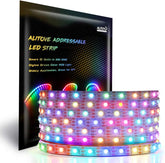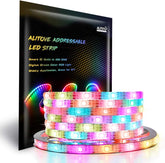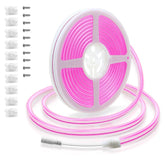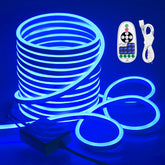LED Strip Lights: A Comprehensive Guide to Making the Right Choice
Welcome to the ultimate guide on choosing the perfect LED strip lights! Whether you’re looking to add ambiance to your living room, brighten up your kitchen, or create a cozy bedroom atmosphere, LED strip lights are the ideal solution. In this guide, I’ll cover different types of LED strip lights, how to choose the right brightness, the importance of color temperature, and the differences between white and RGB lights. I’ll also provide a step-by-step installation guide, tips on powering your lights, creative usage ideas, and troubleshooting common issues. Let’s dive in and light up your life with the perfect LED strip lights!
Here are 10 tips related to choosing the right LED strip lights:
- Determine Your Purpose: Identify whether you need LED strip lights for accent lighting, task lighting, or decorative purposes.
- Choose the Right Type: Select between single-color, RGB, or RGBW LED strip lights based on your lighting needs.
- Consider Brightness: Choose the appropriate brightness level (measured in lumens) for the specific area you want to illuminate.
- Select Color Temperature: Decide on the color temperature (warm, neutral, or cool white) that best suits the ambiance you want to create.
- Check Power Requirements: Ensure you have a compatible power supply that matches the voltage and wattage requirements of your LED strip lights.
- Measure and Cut: Measure the area where you want to install the lights and cut the strip to the desired length at designated cutting points.
- Plan Installation: Clean the surface, peel off the adhesive backing, and stick the strip in place. Use additional connectors for corners or complex installations.
- Use Controllers: Consider using controllers or dimmers to adjust brightness and color settings for added flexibility.
- Ensure Safety: Follow the manufacturer’s instructions and consult an electrician if needed to ensure safe installation and operation.
- Regular Maintenance: Periodically check connections and clean the strips to maintain optimal performance and longevity.
Understanding Different Types of LED Strip Lights
LED strip lights come in various types, each suited for different applications. The most common types include single-color, RGB (Red, Green, Blue), and RGBW (RGB + White) strips. Single-color strips are great for simple lighting needs, while RGB and RGBW strips offer a range of colors and effects, perfect for creating dynamic lighting environments. Additionally, there are waterproof and non-waterproof options, as well as different densities of LEDs per meter, which affect the brightness and uniformity of the light.
How to Choose the Right Brightness for Your LED Strip Lights:
The brightness of LED strip lights is measured in lumens. When choosing the right brightness, consider the purpose of the lighting. For accent lighting, lower lumens (around 200-500 lumens per meter) are sufficient. For task lighting, such as under-cabinet lighting in the kitchen, higher lumens (around 1000-1500 lumens per meter) are needed. It’s also important to consider the color of the walls and the size of the room, as these factors can affect the perceived brightness.
The Importance of Color Temperature in LED Strip Lights:
Color temperature, measured in Kelvin (K), determines the warmth or coolness of the light. Warm white (2700K-3000K) creates a cozy and inviting atmosphere, ideal for living rooms and bedrooms. Neutral white (3500K-4000K) is suitable for kitchens and workspaces, providing a balance between warmth and clarity. Cool white (5000K-6500K) is best for task-oriented areas like garages and workshops, as it mimics daylight and enhances visibility.
Comparing White vs. RGB LED Strip Lights:
White LED strip lights are perfect for general illumination and creating a clean, modern look. They are available in various color temperatures to suit different needs. RGB LED strip lights, on the other hand, offer a wide range of colors and can create dynamic lighting effects. They are ideal for parties, mood lighting, and creative projects. Some RGB strips also include white LEDs (RGBW) for added versatility.
How to Install LED Strip Lights: A Step-by-Step Guide:
Installing LED strip lights is a straightforward process. First, measure the area where you want to install the lights and cut the strip to the desired length. Clean the surface to ensure proper adhesion. Peel off the backing and stick the strip in place. Connect the strip to a power supply and controller, if applicable. Finally, test the lights to ensure they are working correctly. For more complex installations, such as around corners or in hard-to-reach areas, additional connectors and accessories may be needed.
Powering Your LED Strip Lights: What You Need to Know:
LED strip lights require a power supply that matches their voltage and wattage requirements. Most strips operate on 12V or 24V DC. Calculate the total wattage of your strip by multiplying the wattage per meter by the length of the strip. Choose a power supply with a wattage rating at least 20% higher than the total wattage to ensure reliable operation. For longer runs, consider using multiple power supplies or amplifiers to prevent voltage drop.
Creative Ways to Use LED Strip Lights in Your Home:
LED strip lights are incredibly versatile and can be used in various creative ways. Use them to highlight architectural features, such as coves and niches. Install them under cabinets and shelves for task lighting. Create a stunning backlight for your TV or computer monitor. Use them to illuminate staircases and hallways for added safety. The possibilities are endless, limited only by your imagination.
How to Choose the Best LED Strip Lights for Different Rooms:
Different rooms have different lighting needs. In the living room, use warm white LED strips to create a cozy atmosphere. In the kitchen, opt for neutral white strips for clear, bright task lighting. In the bedroom, consider RGB strips to create a relaxing or romantic ambiance. For outdoor spaces, choose waterproof LED strips to withstand the elements. Tailor your choice to the specific requirements of each room.
The Benefits of Using LED Strip Lights for Home Decor:
LED strip lights offer numerous benefits for home decor. They are energy-efficient, consuming less power than traditional lighting. They have a long lifespan, reducing the need for frequent replacements. They are flexible and can be cut to fit any space. They are available in a wide range of colors and brightness levels, allowing for endless customization. Additionally, they are easy to install and can be controlled remotely for added convenience.
Troubleshooting Common Issues with LED Strip Lights:
Sometimes, LED strip lights may encounter issues such as flickering, dimming, or not turning on. Common causes include loose connections, insufficient power supply, or damaged strips. Check all connections and ensure the power supply is adequate for the length of the strip. If a section of the strip is not working, it may need to be replaced. Regular maintenance and proper installation can help prevent these issues.
Don’t miss out on the perfect lighting solution! Click here to explore our wide range of LED strip lights and find the best fit for your needs. Or contact us for custom wholesale of your led strip lights.

Conclusion
choosing the right LED strip lights can transform your home into a beautifully illuminated space. By understanding the different types, brightness levels, color temperatures, and installation methods, you can make an informed decision that suits your needs. Whether you’re looking to add ambiance, enhance task lighting, or create a stunning decorative effect, LED strip lights offer endless possibilities. Don’t wait any longer – explore your options and light up your life with the perfect LED strip lights today!
FAQ:
What are LED strip lights?
LED strip lights are flexible circuit boards populated with LEDs (light-emitting diodes) that emit light. They are versatile and can be used for various lighting applications, such as accent lighting, task lighting, and decorative lighting.
Are LED strip lights dimmable?
Yes, many LED strip lights are dimmable. However, you need to ensure that you have a compatible dimmer switch and a dimmable LED driver to control the brightness effectively.
Do LED strip lights need a driver?
Yes, LED strip lights require a driver to convert the AC power supply to the DC power needed by the LEDs. The driver must match the voltage and wattage requirements of the LED strip.
Are LED strip lights safe?
LED strip lights are safe when installed and used correctly. They produce less heat compared to traditional lighting sources, reducing the risk of burns or fire hazards. However, it’s essential to follow the manufacturer’s instructions and consult an electrician if needed.
Are LED strip lights energy-efficient?
Yes, LED strip lights are highly energy-efficient. They convert a significant portion of energy into light, consuming less power and reducing electricity bills compared to traditional lighting sources.
How long do LED strip lights last?
LED strip lights have a long lifespan, typically ranging from 25,000 to 50,000 hours, depending on the quality and usage. This means they can last for several years with regular use.
Can LED strip lights be cut to size?
Yes, most LED strip lights can be cut to size at designated cutting points, usually marked on the strip. This allows you to customize the length to fit your specific needs.
Where can I use LED strip lights?
LED strip lights can be used in various locations, such as under cabinets, along staircases, behind TVs, in coves, and even outdoors (if they are waterproof). They are perfect for adding ambiance and highlighting architectural features.
How do I install LED strip lights?
Installing LED strip lights is relatively simple. Clean the surface where you want to install the lights, peel off the adhesive backing, and stick the strip in place. Connect the strip to a power supply and controller, if applicable, and test the lights to ensure they work correctly.
What should I do if my LED strip lights are not working?
If your LED strip lights are not working, check the connections to ensure they are secure. Verify that the power supply is adequate for the length of the strip and that there are no damaged sections. If the problem persists, consult the manufacturer’s troubleshooting guide or seek professional assistance.
Quote:
Environmental and Energy Considerations: The Sustainable Side of LED Strip Lights:
A Comprehensive Guide to Choosing LED Strip Lights:
Everything You Need To Know About LED Strip Lights: Definitive Guide:





















Leave a comment
Please note, comments need to be approved before they are published.